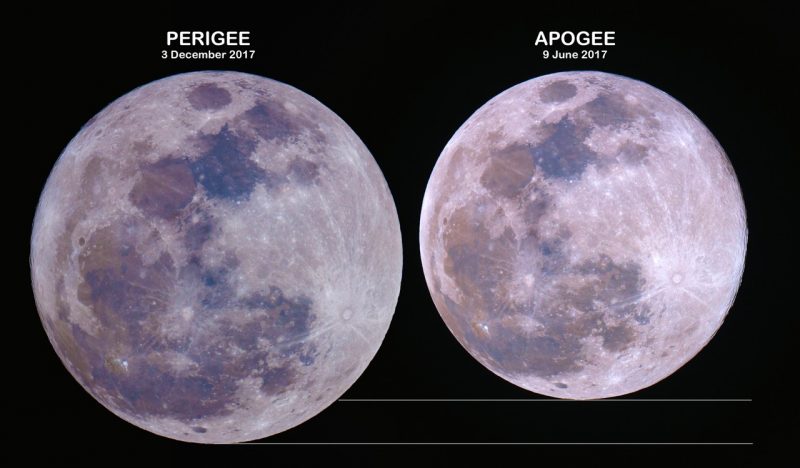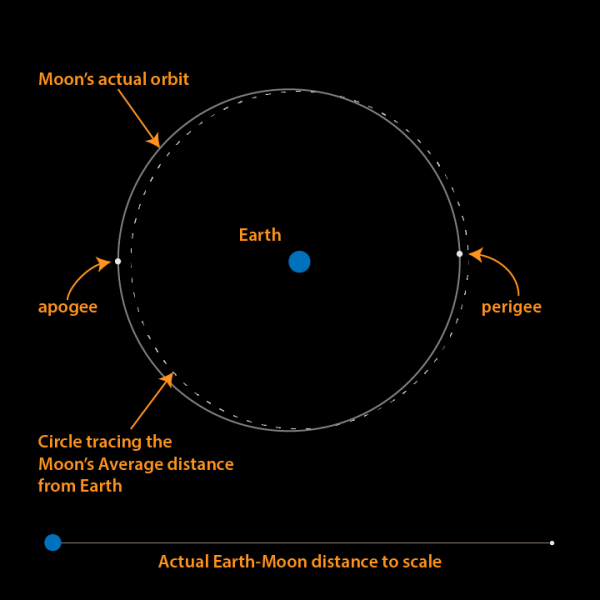

Here’s a comparison between the December 3, 2017, full moon at perigee (closest to Earth for the month) and 2017’s farthest full moon in June at apogee (farthest from Earth for the month) by Muzamir Mazlan at Telok Kemang Observatory, Port Dickson, Malaysia.
The moon’s distance from Earth varies throughout its monthly orbit because the moon’s orbit isn’t perfectly circular. Every month, the moon’s eccentric orbit carries it to apogee – its most distant point from Earth – and then, some two weeks later, to perigee – the moon’s closest point to Earth in its monthly orbit.
EarthSky lunar calendars are cool! They make great gifts. Order now. Going fast!
In this post, beneath the illustration below, we list the year’s 14 apogees and 13 perigees. Yes, the moon’s apparent size in our sky does change across this cycle of the moon. The variation in the moon’s apparent size is akin to that of a U.S. quarter versus a U.S. nickel.
Also in this post, we share with you a little-known fact about the intriguing cycle of close and far moons.
This year’s farthest apogee comes on March 24, 2020 (252,707 miles or 406,692 km), and the closest perigee occurs some 2 weeks later, on April 7 (221,772 miles or 356,907 km). That’s a difference of about 30,000 miles (50,000 km). Meanwhile, the moon’s mean distance (semi-major axis) from Earth is 238,855 miles (384,400 km).

The moon’s orbit around Earth isn’t a circle, but it’s very nearly circular, as the above diagram shows. Diagram by Brian Koberlein. Used with permission.
Lunar apogees and perigees in 2020
| Apogee | Perigee | |
| Jan 02 | Jan 13 | |
| Jan 29 | Feb 10 | |
| Feb 26 | Mar 10 | |
| Mar 24 | Apr 07 | |
| Apr 20 | May 06 | |
| May 18 | June 03 | |
| June 15 | June 30 | |
| July 12 | July 25 | |
| Aug 09 | Aug 21 | |
| Sept 06 | Sept 18 | |
| Oct 03 | Oct 16 | |
| Oct 30 | Nov 14 | |
| Nov 27 | Dec 12 | |
| Dec 24 |
Enjoying EarthSky so far? Sign up for our free daily newsletter today!
Amazingly, in periods of four years, lunar apogees and perigees fall on the same, or nearly the same calendar dates. Let’s look four years ahead, to the year 2024:
Lunar apogees and perigees in 2024
| Apogee | Perigee | |
| Jan 01 | Jan 13 | |
| Jan 29 | Feb 10 | |
| Feb 25 | Mar 10 | |
| Mar 23 | Apr 07 | |
| Apr 20 | May 05 | |
| May 17 | June 02 | |
| June 14 | June 27 | |
| July 12 | July 24 | |
| Aug 09 | Aug 21 | |
| Sept 05 | Sept 18 | |
| Oct 02 | Oct 17 | |
| Oct 29 | Nov 14 | |
| Nov 26 | Dec 12 | |
| Dec 24 |
Also, in cycles of two years, the calendar dates remain the same, or nearly so, except that the lunar apogees and perigees trade places. For instance, let’s look two years beyond 2020, to the year 2022:
Lunar perigees and apogees in 2022
| Perigee | Apogee | |
| Jan 01 | Jan 14 | |
| Jan 30 | Feb 11 | |
| Feb 26 | Mar 10 | |
| Mar 23 | Apr 07 | |
| Apr 19 | May 05 | |
| May 17 | June 02 | |
| June 14 | June 29 | |
| July 13 | July 26 | |
| Aug 10 | Aug 22 | |
| Sept 07 | Sept 19 | |
| Oct 04 | Oct 17 | |
| Oct 29 | Nov 14 | |
| Nov 26 | Dec 12 |
Want to know more? Here’s for a complete listing of all lunar perigees and apogees for the 21st century (2001 to 2100) and a perigee and apogee calculator.
Here’s a little-known fact of the moon’s apogee/perigee cycle, among both professional astronomers and lay people. That is, the cycle causes lunar apogees and perigees to align on the same, or nearly the same, calendar dates every four years. That’s because 53 returns to perigee (or apogee) are nearly commensurate with four calendar years.
The mean length of the anomalistic month (perigee to perigee, or apogee to apogee) is 27.55455 days, whereas the average Gregorian year equals 365.2425 days. Hence:
27.55455 x 53 = 1460.3912 days
365.2425 x 4 = 1460.97 days

This animation by Peter Lowenstein in Zimbabwe contrasts the size of the May 27, 2017, waxing crescent moon, which was close to Earth, with the June 9, 2017, full moon, which was far from Earth. Read more about this image.
Bottom line: In periods of four years, lunar apogees and perigees fall on the same, or nearly the same, calendar dates.
from EarthSky https://ift.tt/2QlfXCt


Here’s a comparison between the December 3, 2017, full moon at perigee (closest to Earth for the month) and 2017’s farthest full moon in June at apogee (farthest from Earth for the month) by Muzamir Mazlan at Telok Kemang Observatory, Port Dickson, Malaysia.
The moon’s distance from Earth varies throughout its monthly orbit because the moon’s orbit isn’t perfectly circular. Every month, the moon’s eccentric orbit carries it to apogee – its most distant point from Earth – and then, some two weeks later, to perigee – the moon’s closest point to Earth in its monthly orbit.
EarthSky lunar calendars are cool! They make great gifts. Order now. Going fast!
In this post, beneath the illustration below, we list the year’s 14 apogees and 13 perigees. Yes, the moon’s apparent size in our sky does change across this cycle of the moon. The variation in the moon’s apparent size is akin to that of a U.S. quarter versus a U.S. nickel.
Also in this post, we share with you a little-known fact about the intriguing cycle of close and far moons.
This year’s farthest apogee comes on March 24, 2020 (252,707 miles or 406,692 km), and the closest perigee occurs some 2 weeks later, on April 7 (221,772 miles or 356,907 km). That’s a difference of about 30,000 miles (50,000 km). Meanwhile, the moon’s mean distance (semi-major axis) from Earth is 238,855 miles (384,400 km).

The moon’s orbit around Earth isn’t a circle, but it’s very nearly circular, as the above diagram shows. Diagram by Brian Koberlein. Used with permission.
Lunar apogees and perigees in 2020
| Apogee | Perigee | |
| Jan 02 | Jan 13 | |
| Jan 29 | Feb 10 | |
| Feb 26 | Mar 10 | |
| Mar 24 | Apr 07 | |
| Apr 20 | May 06 | |
| May 18 | June 03 | |
| June 15 | June 30 | |
| July 12 | July 25 | |
| Aug 09 | Aug 21 | |
| Sept 06 | Sept 18 | |
| Oct 03 | Oct 16 | |
| Oct 30 | Nov 14 | |
| Nov 27 | Dec 12 | |
| Dec 24 |
Enjoying EarthSky so far? Sign up for our free daily newsletter today!
Amazingly, in periods of four years, lunar apogees and perigees fall on the same, or nearly the same calendar dates. Let’s look four years ahead, to the year 2024:
Lunar apogees and perigees in 2024
| Apogee | Perigee | |
| Jan 01 | Jan 13 | |
| Jan 29 | Feb 10 | |
| Feb 25 | Mar 10 | |
| Mar 23 | Apr 07 | |
| Apr 20 | May 05 | |
| May 17 | June 02 | |
| June 14 | June 27 | |
| July 12 | July 24 | |
| Aug 09 | Aug 21 | |
| Sept 05 | Sept 18 | |
| Oct 02 | Oct 17 | |
| Oct 29 | Nov 14 | |
| Nov 26 | Dec 12 | |
| Dec 24 |
Also, in cycles of two years, the calendar dates remain the same, or nearly so, except that the lunar apogees and perigees trade places. For instance, let’s look two years beyond 2020, to the year 2022:
Lunar perigees and apogees in 2022
| Perigee | Apogee | |
| Jan 01 | Jan 14 | |
| Jan 30 | Feb 11 | |
| Feb 26 | Mar 10 | |
| Mar 23 | Apr 07 | |
| Apr 19 | May 05 | |
| May 17 | June 02 | |
| June 14 | June 29 | |
| July 13 | July 26 | |
| Aug 10 | Aug 22 | |
| Sept 07 | Sept 19 | |
| Oct 04 | Oct 17 | |
| Oct 29 | Nov 14 | |
| Nov 26 | Dec 12 |
Want to know more? Here’s for a complete listing of all lunar perigees and apogees for the 21st century (2001 to 2100) and a perigee and apogee calculator.
Here’s a little-known fact of the moon’s apogee/perigee cycle, among both professional astronomers and lay people. That is, the cycle causes lunar apogees and perigees to align on the same, or nearly the same, calendar dates every four years. That’s because 53 returns to perigee (or apogee) are nearly commensurate with four calendar years.
The mean length of the anomalistic month (perigee to perigee, or apogee to apogee) is 27.55455 days, whereas the average Gregorian year equals 365.2425 days. Hence:
27.55455 x 53 = 1460.3912 days
365.2425 x 4 = 1460.97 days

This animation by Peter Lowenstein in Zimbabwe contrasts the size of the May 27, 2017, waxing crescent moon, which was close to Earth, with the June 9, 2017, full moon, which was far from Earth. Read more about this image.
Bottom line: In periods of four years, lunar apogees and perigees fall on the same, or nearly the same, calendar dates.
from EarthSky https://ift.tt/2QlfXCt

Aucun commentaire:
Enregistrer un commentaire